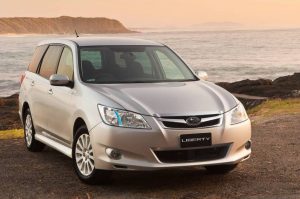Recalls: Subaru BR Liberty Exiga
Overview
Manufacturers, or importers, issue recalls for defects or faults which have the potential to cause injury. Generally, manufacturers will inform the original buyers if their vehicle is subject to a recall and of the steps required to remedy the defect or fault. Please note that the recalls below (if any) are for Australian-delivered vehicles only. Furthermore, the number of recalls should not be taken as an indication of a model’s reliability or its safety more generally.
Recalls: Subaru BR Liberty Exiga
2010 model year Subaru Liberty Exiga: transmission oil leak
In May 2010, a recall was issued for 2010 model year Subaru Liberty models fitted with the continuously variable transmission (CVT) and in the chassis range 002086 to 006056. For these vehicles, the transmission may experience an oil leak from a faulty oil cooler hose.
2010-14 model year Subaru Liberty Exiga: Takata airbag recall
In April 2017, a recall was issued for 2010 to 2014 model year Subaru Liberty Exiga vehicles, though this recall was extended on 12 November 2017 and 18 April 2018. In these vehicles, the front passenger’s airbag contained propellant wafers which may absorb moisture over time. The airbag may therefore expand more aggressively than intended and cause the airbag inflator housing to rupture, dispersing metallic fragments throughout the cabin. These fragments had the potential to cause serious injury to vehicle occupants. For the VINs of the recalled Subaru Liberty Exiga vehicles, please see PRA 2017/16012.
Subaru YA Liberty Exiga: defective replacement ignition switch
In June 2019, recall campaign SRT 272 was issued for Subaru YA Liberty Exiga vehicles because a replacement ignition switch may have had imperfections in its ball springs. Over time, these imperfections could cause the ignition switch to fail and the key may inadvertently move from the ‘ON’ position to the ‘ACC’ position while the vehicle was moving. If this occurred, the engine would stop running (causing the vehicle to unexpectedly slow down and stop) and the power supply to the SRS airbag would be cut (so that the airbag would not deploy in the event of a collision). As such, the vehicle would pose a hazard to occupants and other road users. For the VINs of the recalled vehicles, please see PRA 2019/17514.
Search online for recalls by VIN
To see if a Subaru vehicle has been recalled, you can conduct a search on the Subaru Australia website using its VIN.
Problems and faults: Subaru BR Liberty Exiga
Overview
This section identifies potential problems, causes and fixes based on the experiences of owners and repairers, online sources and technical service bulletins. This information is provided solely for reference purposes and AustralianCar.Reviews recommends that only properly qualified persons carry out repairs or modifications. Furthermore, the number of items below should not be taken as an indicator of a model’s reliability or the frequency with which they may occur.
To report a problem or fault to the AustralianCar.Reviews team, please use the Contact Us form. Note that AustralianCar.Reviews does not offer advice on automotive problems or disputes; such enquiries will not receive a reply. For vehicles purchased from dealers after 1 January 2011, please see our Australian Consumer Law fact sheet.
CVT torque converter
In January 2014, technical service bulletin (# 16-90-13) was issued for BM/BR Liberty and BR Outback vehicles with 2.5-litre petrol engines and continuously variable transmissions. In these vehicles, the driver may experience low engine RPM when coming to rest (similar to a vehicle with a manual transmission stalling as it comes to rest due to the clutch pedal not being depressed). This occurred because thrust washer wear inside the torque converter could cause restriction of the oil passage used to bleed off lock-up clutch application pressure. In turn, this could cause either a delay (momentary low engine rpm) or no lock-up pressure release. As a result of this problem, Subaru changed the design of the torque converter whereby the solid bushing-type thrust washer was replaced by a needle bearing type.
EJ25 head gasket failure
In rare cases, the 2.5-litre EJ253 F4 engines may experience head gasket failure due to external oil leaks or warped cylinder heads.
- Symptoms: early signs of head gasket failure include an oily residue in the coolant overflow bottle, or an exhaust/fuel/sulfur smell in the coolant overflow bottle. Beyond this, the coolant temperature gauge may intermittently show higher-than-normal readings, followed by intermittent overheating (particularly during long highway drives). In the case of external leaks, these can be spotted by a visual inspection of the bottom side of the engine with the splash pan removed.
- Prevention: to minimise the risk of head gasket failure, 1) oil and coolant should be changed regularly and in accordance with how the car is used. As such, the scheduled time/kilometre intervals may be inadequate in some cases; and, 2) any corrosion around battery cables should be removed. Corroded battery cables increased ground circuit resistance, thereby increasing the voltage in the cooling system and causing electrolysis; the coolant could also damage the metal head gasket and seals.
‘Lineartronic’ CVT slow to engage drive/reverse
Subaru’s ‘Lineartronic’ continuously variable transmissions (CVTs) are slower to shift to/from reverse or drive than conventional automatic transmissions – this occurs because significant pressure must be generated before the sheaves (i.e. the sides of the pulley that contact the metal belt) can clamp the belt such that it will not slip. According to Subaru service manuals, the normal delay or lag when switching into reverse or drive from park is 1.5 seconds or less.
Some Subaru owners, however, have reported delays of around three (3) or four (4) seconds when switching between reverse and drive. While re-flashing the transmission control module (TCM) and replacing the CVT fluid have reduced the delay to within Subaru’s normal range, the delay has subsequently increased over time.




